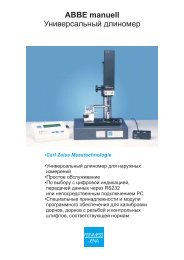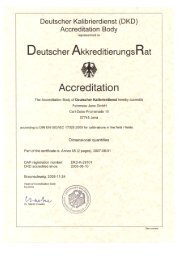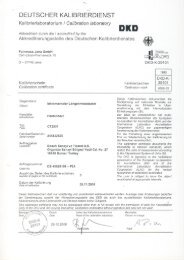EMP 25 Gauge Block Tester
EMP 25 Gauge Block Tester
EMP 25 Gauge Block Tester
Create successful ePaper yourself
Turn your PDF publications into a flip-book with our unique Google optimized e-Paper software.
<strong>EMP</strong> <strong>25</strong><br />
<strong>Gauge</strong> <strong>Block</strong> <strong>Tester</strong><br />
● Adds efficiency to your gauge block<br />
testing and in-plant calibration processes<br />
● DKD- and factory calibration<br />
● Rectangular and square gauge blocks<br />
● Determines DIN ISO 3650 characteristics<br />
● Save considerable time and cost
General <strong>EMP</strong> <strong>25</strong><br />
Application The <strong>EMP</strong><strong>25</strong> is used for calibrating parallel-faced end standards of rectangular and square<br />
cross section (gauge blocks) with gauge lengths from 0.5 to 100 (500) mm<br />
Measuring method Direct measurement<br />
Measuring set-up An inductive probe and an high-resolution incremental probe (with a direct measuring range<br />
of <strong>25</strong> mm) are connected in a summation circuit to measure gauge length and range of error<br />
Software Powerful measurement and data handling software for efficient, economic gauge block<br />
calibration<br />
Advantages<br />
●Enormous saving on recalibration cost:<br />
Only 11 reference standards needed for zero adjustment up to 100 mm<br />
●About 50% less measuring time:<br />
Upper probe needs no adjustment over <strong>25</strong> mm few reference standards to be used<br />
●Single measuring range fits any gauge block up to 100 (500) mm<br />
●Partly automatic measurement procedure<br />
●Extensive PC software running under Windows 2000/XP<br />
●National and company standards can be created<br />
Concept<br />
The conventional comparative measurement of gauge blocks involves high recalibration costs, as you need to have a large stock<br />
of calibrated standards. Above all, it is extremely time-consuming. The innovative technique using a long range probe does away<br />
with these drawbacks, simply by increasing the measuring range of the upper probe from ± 20 µm to <strong>25</strong> mm, while retaining the<br />
resolution of 0.01 (0.001) µm. This makes it possible to measure all gauge blocks in a single <strong>25</strong> mm measuring range relative to a<br />
reference position. The reference position can be defined, e.g., by measuring a standard and setting the display to the measured<br />
length of the standard. To minimize linear errors of the instrument as a whole (aligning error, probe non-perpendicularity,<br />
temperature influences), the system uses a calibration method which registers and compensates detectable systematic measuring<br />
errors.<br />
Specifications<br />
Incremental Probe<br />
Type CT<strong>25</strong>01<br />
Direct measuring range <strong>25</strong> mm<br />
Measuring system DIADUR-transmitted-light scale and encoder Zerodur Ceramic a=(0±0.1)*10-6K-1<br />
Resolution 0.01 (0.001) µm<br />
Uncertainty of measurement (0.03+L/1000) µm<br />
Measuring pressure 1 N<br />
Thread for screw-in stylus M 2.5<br />
Contact tip Contact tip with spherical section R=20<br />
<strong>EMP</strong><strong>25</strong><br />
Resolution 0.01 (0.001) µm<br />
Uncertainty of measurement (0.05+L/1000) µm<br />
Repeatability 0.03 µm<br />
Ambient temperature for ensuring<br />
the specified length measuring Temperature 20°C ± 0.5K<br />
uncertainty ΔT=0.2 K/h<br />
Feinmess Jena GmbH<br />
Carl–Zeiss–Promenade 10<br />
D-07745 Jena<br />
Tel.: (+49-3641) 643216<br />
Fax: (+49-3641) 643210<br />
www.feinmess-jena.de<br />
e-mail: grafe@feinmess-jena.de









